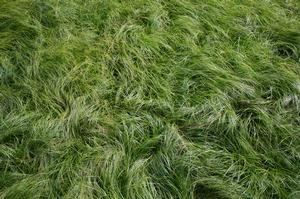Printed at http://www.newmoonnursery.com/index.cfm/
Carex socialis
Social sedge, low woodland sedge
Native to North America
FIRST IMPRESSIONS: Carex socialis is a rhizomatous perennial sedge that forms dense tufts of narrow foliage. The leaves are light green and semi-evergreen. In late spring green elongated flower spikes are displayed above the foliage. This sedge occurs in part shade to partly sunny moist, wet or seasonally flooded woods. It also has great landscape potential as a woodland groundcover or fine textured addition to a rain garden.
HABITAT & HARDINESS: Carex socialis is native to the eastern United States from North Carolina to Georgia and west to Oklahoma and Texas. The range extends north into Kentucky, Missouri, southern Illinois and southern Indiana.
Plants are indigenous to alluvial floodplain forests, lowland deciduous forests, banks of streams and rivers, slopes bordering floodplains, sloughs, margins of swamps, wet or seasonally flooded woods and flatwoods. The preference is for sites with clay or silty soils and woods with an open canopy.
Hardy from USDA Zones 5-9.
PLANT DESCRIPTION: Carex socialis grows in compact clumps of delicate arching foliage. Plants have long creeping rhizomes that allow them to expand to form fairly large colonies.
Leaves are light green and about 1/16” wide. The narrow blades are evergreen through most of the range.
In spring several upright culms bear 3-5 well separated green spikes. The terminal spike usually contains both staminate and pistillate florets. The lower spikes have only pistillate florets. Each spike contains 4-9 spreading sharply pointed perigynia.
This sedge is 1-2’ tall with an equal spread.
CULTURAL & MAINTENANCE NEEDS: Carex socialis prospers in moist or wet woods. The preferred exposure is dappled sunlight or part shade.
This sedge performs well in heavy clay soils and is tolerant of seasonally wet sites that become dry during summer.
Established plants are drought tolerant, pest resistant and unpalatable to deer and other herbivores.
In garden situations, plants can be cut to the ground during late winter before new growth is initiated.
LANDSCAPE USES: Carex socialis is a valuable Groundcover or Edging Plant for a moist Shade Garden. This sedge is lovely when Grouped or Massed with spring wildflowers or ferns. The unique leaf texture allows this sedge to serve as an eye catching Accent. Plants provide Erosion Control and Winter Interest and are appropriate for Deer Resistant Plantings, Low Maintenance Plantings, Rain Gardens, Wetlands and Wildlife Gardens.
This sedge is an excellent native substitute for the popular Asian groundcovers Liriope muscari and Ophiopogon japonicus.
COMPANION & UNDERSTUDY PLANTS: Suitable garden companions for Carex socialis could include Amsonia tabernaemontana, Asclepias verticillata, Boltonia asteroides, and Ruellia humilis.
If a substitute is needed, several Carex spp. are similar in appearance and shade tolerant but most will not tolerate wet sites with clay soils. Carex rosea and Carex radiata offer the same fine textured foliage and low growth but these two are not rhizomatous and would require a more upland site. Carex texensis could be substituted in a moist or wet sandy site. Carex appalachica or Carex pensylvanica could work as a substitute in dry shade.
TRIVIA: The common name “social sedge” is said to be due to this plant’s inclination to form large colonies.
Height:
1-2 ftSpread:
1-2 ftSpacing:
24-36 inUSDA Hardiness Zone:
5-9Bloom Color:
GreenCarex socialis Characteristics
Attracts Wildlife
- Pollinators
Attributes
- Naturalizing
- Ground Cover
- East-Coast Native
- Rain Garden
- Drought Tolerant
- Clay Soil
Exposure
- Full Sun to Full Shade
Deer Resistant
- Deer Resistant
Flowering Months
- June
Foliage Color
- Green
Grass Season
- Cool Season Grass
Groundcover Foot-Traffic Tolerances
- Light
Growth Rate
- Medium
Lawn Replacement or Groundcover
- Groundcover
Season of Interest (Foliage)
- Spring
- Fall
- Summer
Soil Moisture Preference
- Dry
- Wet to Moist

